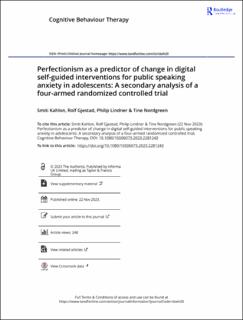| dc.contributor.author | Kahlon, Smiti | |
| dc.contributor.author | Gjestad, Rolf | |
| dc.contributor.author | Lindner, Philip | |
| dc.contributor.author | Nordgreen, Tine | |
| dc.date.accessioned | 2024-03-19T09:59:46Z | |
| dc.date.available | 2024-03-19T09:59:46Z | |
| dc.date.created | 2023-11-24T11:26:53Z | |
| dc.date.issued | 2024 | |
| dc.identifier.issn | 1650-6073 | |
| dc.identifier.uri | https://hdl.handle.net/11250/3123055 | |
| dc.description.abstract | Public Speaking Anxiety (PSA) interventions targeting adolescents exist; however, not all gain improvement. This exploratory study investigated whether PSA interventions resulted in a decrease in perfectionism and whether pre-treatment level and changes in perfectionism moderated the effects on PSA and social anxiety. The sample consisted of 100 adolescents from junior high schools randomized to four groups: 1) VR only (n = 20), 2) VR + online exposure program (n = 20), 3) online psychoeducation and online exposure program (n = 40), 4) waitlist and online psychoeducation program (n = 20). Self-reported symptoms of PSA, social anxiety, and perfectionism were measured at pre, week 3, post, and 3-months follow-up. Level and change in outcome variables were analyzed using latent growth curve modeling. Results revealed that the interventions did not lead to a reduction in perfectionism. Reduction in perfectionism was associated with a larger reduction in all outcome measures from post to follow-up. No interaction was found between pre-treatment perfectionism and PSA symptoms. High pre-treatment levels of perfectionism were associated with poorer outcomes on social anxiety symptoms from post to follow-up for online exposure groups. The results indicate that one should assess and address high pre-treatment levels of perfectionism during PSA interventions. | en_US |
| dc.language.iso | eng | en_US |
| dc.publisher | Taylor & Francis | en_US |
| dc.rights | Navngivelse 4.0 Internasjonal | * |
| dc.rights.uri | http://creativecommons.org/licenses/by/4.0/deed.no | * |
| dc.title | Perfectionism as a predictor of change in digital self-guided interventions for public speaking anxiety in adolescents: A secondary analysis of a four-armed randomized controlled trial | en_US |
| dc.type | Journal article | en_US |
| dc.type | Peer reviewed | en_US |
| dc.description.version | publishedVersion | en_US |
| dc.rights.holder | Copyright 2023 The Author(s) | en_US |
| cristin.ispublished | true | |
| cristin.fulltext | original | |
| cristin.qualitycode | 1 | |
| dc.identifier.doi | 10.1080/16506073.2023.2281243 | |
| dc.identifier.cristin | 2201600 | |
| dc.source.journal | Cognitive Behaviour Therapy | en_US |
| dc.source.pagenumber | 152-170 | en_US |
| dc.relation.project | Norges forskningsråd: 309264 | en_US |
| dc.identifier.citation | Cognitive Behaviour Therapy. 2024, 53 (2), 152-170. | en_US |
| dc.source.volume | 53 | en_US |
| dc.source.issue | 2 | en_US |

